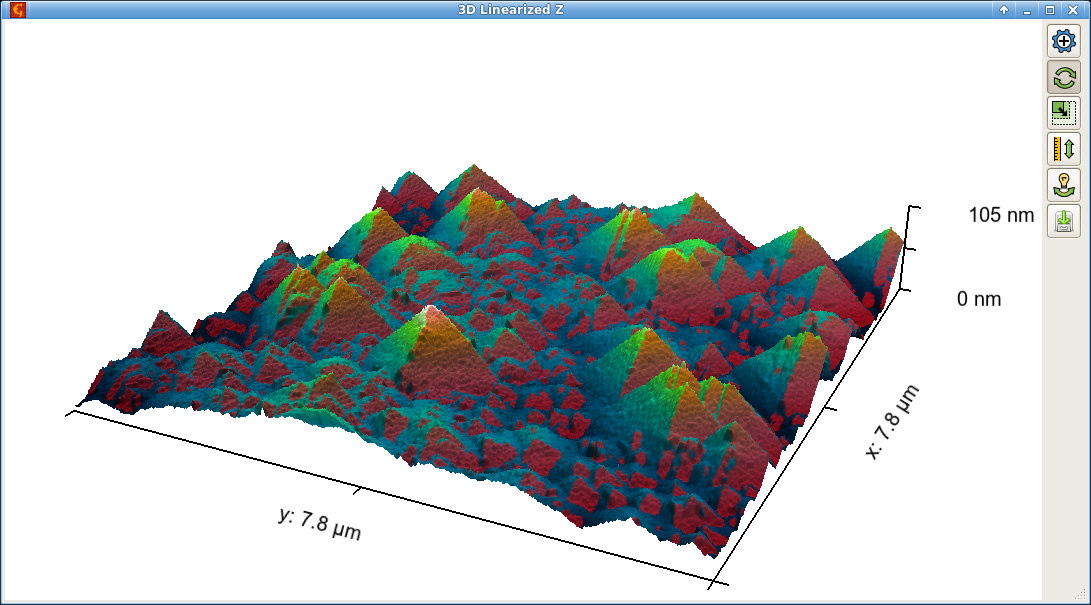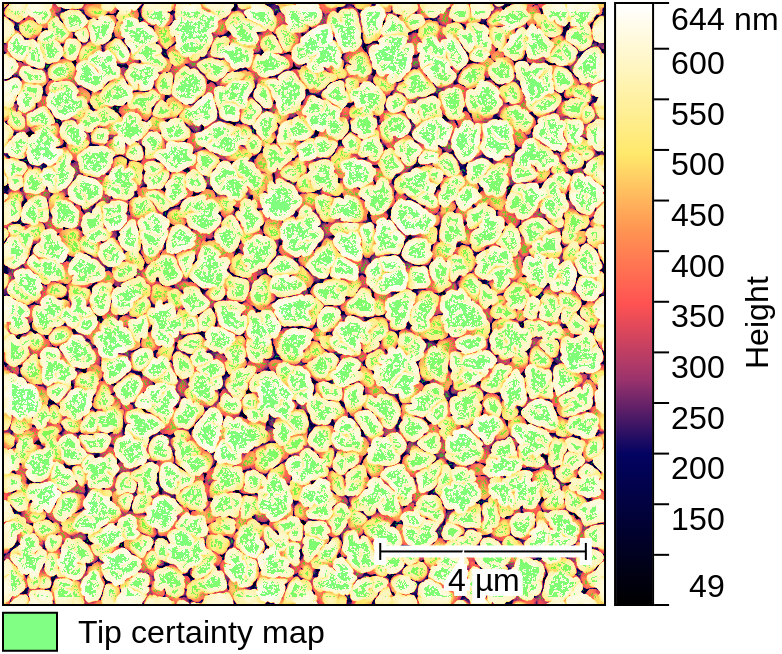Features
Gwyddion is a modular multiplatform software for SPM data analysis. The main idea behind Gwyddion development is to provide modular program for height field and image data processing and analysis that can be easily extended by modules and plug-ins. Moreover, the status of free software enables to provide source codes to developers and users, which makes the further program improvement easier.
Data visualization and processing
The current version Gwyddion provides at least the following visualization and processing functions (this list is updated occasionally):
- visualization: false colour representation with different types of mapping
- shaded, logarithmical, gradient, edge-detected, and local contrast representation, local rank transformation, Canny lines, zero crossing
- OpenGL 3D data display: false colour or material representation
- user-editable false colour gradients and OpenGL materials
- basic operations: rotation, flipping, inversion, data arithmetic, cropping, resampling, binning, thresholding, wraping, extending
- 2D levelling: plane, three-point, facet, polynomial background removal, plane
- scan line corrections: mean, median, trimmed mean, median difference, matching of flat segments, polynomial, levelling along user-defined lines
- value reading: local value reading with slope and curvature measurement, distance and angle measurement
- profile extraction with possible averaging in the orthogonal direction: along scanning axes and along arbitrary lines
- extraction of angularly averaged profiles with automated centring, profiles from multiple images simultaneously, good mean profile from repeated scanning of the same feature
- filtering: mean, median, trimmed mean, conservative denoise, Kuwahara, minimum, maximum, Gaussian, simple sharpening, k-th rank, checker pattern removal
- alternative sequential filters: opening, closing
- statistical characteristics: basic quantities Sa, Sq, mean, median, range, skew and kurtosis, projected and surface area, quick correlation length estimation, entropy
- statistical distributions and histograms: height and angle distributions, 2D slope distribution, 2D angle distribution, Minkowski functionals, area scale graph, local range
- correlation functions and spectral densities: 1D autocorrelation, 2D autocorrelation, 1D height-height correlation (structure function), 1D power spectral density, radial spectral density, 2D spectral density
- facet orientation analysis and measurement
- statistical characterisation of areas under arbitrary masks
- row/column statistical quantities
- ISO roughness parameter evaluation
- grain marking: threshold-based, Otsu's threshold, watershed, segmentation, logistic regression, based on edge detection
- grain measurement: boundary, surface, volume, equivalent ellipses, inscribed and circumscribed circles, Martin diameter and more, individual grain measurement
- grain property statistics: summarisation, statistics, distributions, parameter correlations
- grain filtering: touching edges, by arbitrary properties
- mask editing: adding, removing and intersecting with rectangles and ellipses, growing and shrinking, filling holes, extraction, inversion
- mask combination using logical operations
- basic morphological operations with masks: erosion, dilation, opening, closing, thinning
- alternative sequential filters of masks: opening, closing
- Euclidean distance transform with masks
- integral transforms: 2D fast Fourier transform (FFT), log-φ FFT representation, 2D continuous wavelet transform (CWT), 2D discrete wavelet transform (DWT)
- corrections based on integral transforms: DWT denoising, 1D FFT filtering, 2D FFT filtering, 2D frequency splitting, XY denoising
- fractal dimension analysis
- local data correction by interpolation of bad spots, individual masked regions
- marking of global outliers and local outliers
- Laplace and fractal interpolation
- marking of scars (strokes) and inverted lines
- mutual cropping of non-intersecting parts of images
- automatic XY plane rotation correction
- affine distortion correction
- arbitrary polynomial deformation in XY plane
- deformation using a general displacement-field
- fast scan axis drift correction
- extraction of data along a spline path
- measurement of lattice parameters, step height in amphitheare/terrace structures, global curvature
- general convolution filter with user-defined kernel
- image convolution and deconvolution
- merging, immersion, and stitching of images
- tip modelling, blind estimation, dilation and erosion, certainty map
- magnetic force microscopy (MFM) data recalculation/conversion, simulation, field shifting
- transfer function estimation and fitting
- measurement simulation: PID loop, lateral force
- data processing using neural networks
- simple SEM image simulation
- artificial data generation using: Fourier (frequency space) synthesis, object placement, fibre placement, dynamic spherical particle simulation, dynamic elongated particle simulation, pileup of 3D shapes, predefined patterns (ridges, holes, steps, amphitheatre), columnar film growth simulation, classic ballistic deposition, wave interference, randomized Voronoi/Delaunay lattices, non-equilibrium Ising model, diffusion-limited aggregation, solution of coupled non-linear PDEs, annealing of multi-component mixture, fractional brownian motion, approximation of phase separated structures, tiling with avoidance
- addition of artificial point and line noise
- data modification to enforce given statistical distribution
- finding relation between two images
- graph curve function fitting, critical dimension determination
- manual measurementson graph curves
- graph curve cutting, alignment, levelling, logscale transformation,
- location of peaks in graph curves
- force-distance curve fitting
- statistical quantities and distributions for graph curves
- single point spectroscopy support
- volume data support, summarization and extraction of lower-dimensional data
- volume force-distance curve fitting
- XYZ data as native data
- regularisation of XYZ data to images and some rudimentary XYZ data processing
- curve maps, representing a set of curves in each pixel
- axis scale calibration
Features
Thanks to the Free Software/Open Source nature of Gwyddion, all formulas, methods and algorithms are public and open. Anyone wishing to study or compare the fine calculation details that are beyond the scope of the user guide can read the actual implementation.
All calculations are performed in double precision, and Gwyddion native data format (.gwy) stores data in double precision too. Under normal circumstances, no information is ever lost due to the limited precision or range of values. The Gwyddion data format can contain an arbitrary number of images, graphs, spectra or volume data.
Gwyddion uses a fairly general physical unit system, there are no built-in limitations on the types of physical quantities data (and lateral dimensions) can represent. Units of slopes, areas, volumes, and other derived quantities are correctly calculated. SI unit system is used whenever possible.
Tools and other dialogues remember their parameters, not only between tool invocations within one session, but also across sessions. Gwyddion native file format (.gwy) supports saving all data specific settings: false colour palette, masks, presentations, selections, associated 3D view parameters, graphs associated with that data and their settings, etc.
Most Gwyddion library functions are available in the Python interface pygwy. Gwyddion can be extended by file and processing modules written in Python.
Gwyddion is well integrated to free desktop environments such as GNOME, XFce or KDE, including e.g. menus, file type associations and automated SPM file thumbnailing. Certain integration to other desktop environments also exists, although not to such level.
Many functions support OpenMP parallelisation and can utilise multithreaded processing. This is the default in the program and can be enabled when utilising Gwyddion libraries.
Data formats supported
Gwyddion supports about 140 microscopy and image formats, namely for reading. Several formats can be also written. An up to date complete list of supported file formats is present in the user guide.
We would like to support as many AFM, STM, …, profilometer and general height-field formats as possible, of course. If you want your own format to be supported, please read the file format situation description.
Modularity
The data processing abilities depend on loaded modules abilities. There are already quite a few modules present in the package. However it is possible to add more data processing capabilities to your Gwyddion installation simply by installing new data processing modules, even from third parties.
In a similar way, you can write your own modules, test them on your Gwyddion installation and then send them to other Gwyddion users.
The same statements are valid also for plug-ins that represent other way how to improve Gwyddion. Writing plug-ins can be little bit easier (you can use any programming language, for example). However, you can not use existing Gwyddion data processing functions and widgets when writing plug-ins.
There is documentation on module and plug-in writing available as a part of libgwymodule documentation, sample plug-ins in C/C++, Perl, Python, Ruby, and Pascal are distributed directly with Gwyddion source code, and there is also a sample standalone module available.
An on-line version of module browser is available, in two forms: dynamic, with description pop-ups (needs a modern WWW browser) and a plain expanded table.
If you have any problems or questions concerning module or plug-in development, do not hesitate to ask us.




